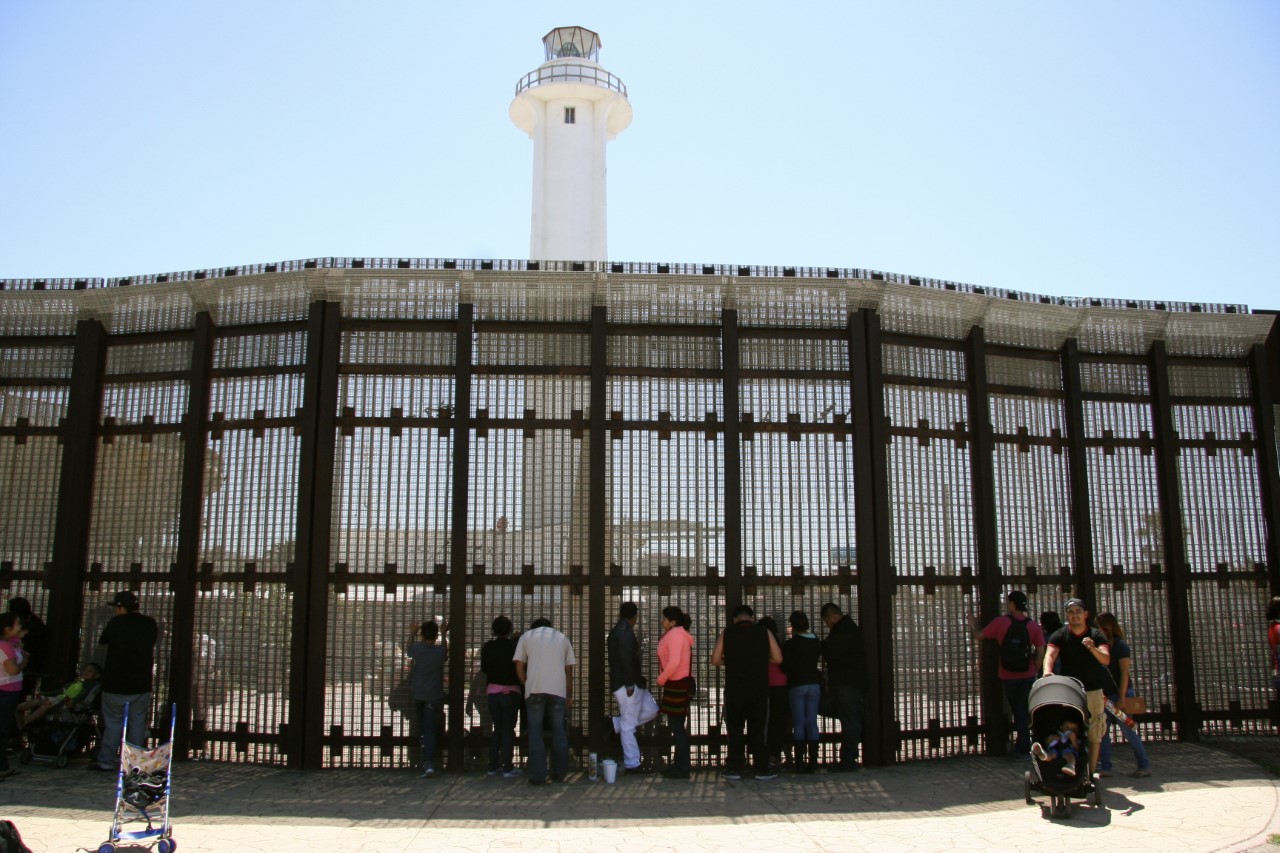
On weekends, visitors arrive at Friendship Park to reunite with their friends and loved ones in Tijuana. Often, these are families who have been separated by deportation. Pedro Rios / AFSC
The strumming of the eight-stringed jaranas could be heard across the border into Mexico from the United States, accompanied by playful, melodious singing, alternating from one side of the metal barrier to the other. The plucking of a harp, the rhythmic foot percussion of the zapateado on the wooden tarima (scaffold), clacking café con pan… café con pan. It was almost enough to forget the presence of vigilant Border Patrol agents and surveillance cameras here at Friendship Park, the southwestern-most corner of the U.S.-Mexico border.
On the last Saturday of May, over 60 musicians and their friends gathered inside the enforcement zone—an area between 18-foot primary and secondary border walls—for the annual bi-national Fandango Fronterizo, playing traditional Mexican son jarocho music. A similar scene played out just on the other side of the barrier in Tijuana, without the encumbrance of law enforcement.

The Fandango Fronterizo is just one of many events organized at Friendship Park, which sits on Monument Mesa inside Border Field State Park. On most weekends, from 10 a.m. to 2 p.m., Border Patrol opens the gate, allowing people to enter the enforcement zone. Visitors are mostly families and friends who have gathered at the park to meet up with their loved ones who live on the other side of the border. Though the primary fence still separates them, they can talk through its steel mesh, small enough to poke a finger through for a pinky kiss.
Since 2007, the Friends of Friendship Park coalition, a mix of individuals and organizations, including AFSC, has advocated for greater access to the area. The secondary fence was built after 2009, following the passage of the REAL ID Act in 2005, which gave the Department of Homeland Security the authority to waive any law, regulation, or treaty. The build-up severely curtailed access to the park, which for decades has served as a rare meeting place to reunite, in some way, families separated by borders and U.S. immigration policies.
Attention to Friendship Park has grown because deportations have continued in record numbers over the last decade. Many park visitors have been victims of punitive immigration enforcement in San Diego and elsewhere. They visit to see their loved ones who have been deported and, with the meshed fence between them, enjoy their afternoon together. Here I have witnessed grandparents meeting their newborn grandchildren for the first time, and I’ve seen others say goodbye to their grandchildren because they have terminal cancer.

Ironically, when then-First Lady Pat Nixon inaugurated the larger Border Field State Park in 1971, at the mesa, she instructed her Secret Service officers to cut the barbed wire separating the U.S. and Mexico, so that she could personally greet the Mexican audience. She is reported to have said, “I hope there won’t be a fence here too much longer.” Events like the Fandango Fronterizo serve as peaceful demonstrations in working to make those words a reality.
 Every year hundreds of people visit the park, making the 1.5-mile trek from the entrance, sometimes walking through sludgy mud to get to the mesa. Many visitors want to counter the enforcement narrative ever-present at Friendship Park. On Sundays, since 2011, the Border Church has celebrated communion at the park as a “practical and symbolic” stance of solidarity for people separated by immigration status. And for the past 22 years, AFSC has co-organized La Posada Sin Fronteras—a bi-national Christmas celebration—with groups in Tijuana and San Diego.
Every year hundreds of people visit the park, making the 1.5-mile trek from the entrance, sometimes walking through sludgy mud to get to the mesa. Many visitors want to counter the enforcement narrative ever-present at Friendship Park. On Sundays, since 2011, the Border Church has celebrated communion at the park as a “practical and symbolic” stance of solidarity for people separated by immigration status. And for the past 22 years, AFSC has co-organized La Posada Sin Fronteras—a bi-national Christmas celebration—with groups in Tijuana and San Diego.
Inside the enforcement zone a short walk from the monument, the Bi-national Friendship Garden, is a commitment from its caretakers of the need to cultivate lasting friendships, in spite of the border walls. It was birthed through acts of civil disobedience. Now it stands as a testament to the spirit of Pat Nixon’s words, of moving away from policies that seek to build walls between two countries and toward policies that recognize the humanity in all people.
 The Friends of Friendship Park Coalition continues to advocate for sensible proposals that will make the area even more accessible, and more humane. A current proposal is to simply allow people to embrace—as people used to do prior to the enhanced security measures in 2005.
The Friends of Friendship Park Coalition continues to advocate for sensible proposals that will make the area even more accessible, and more humane. A current proposal is to simply allow people to embrace—as people used to do prior to the enhanced security measures in 2005.
All of these efforts will continue until the fence is no longer there. Families will continue to use Friendship Park for reunions, and Fandangos will continue to grace the mood with music that crosses border walls—offering a different vision for what true friendship could mean.